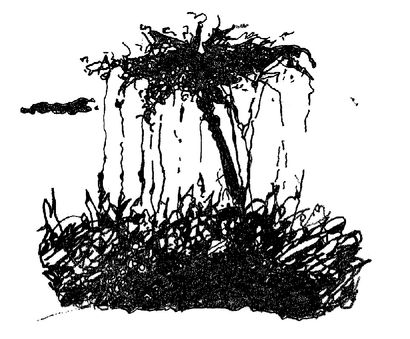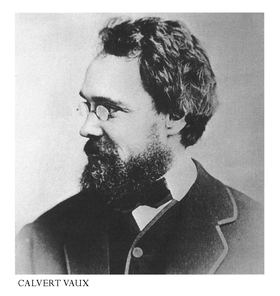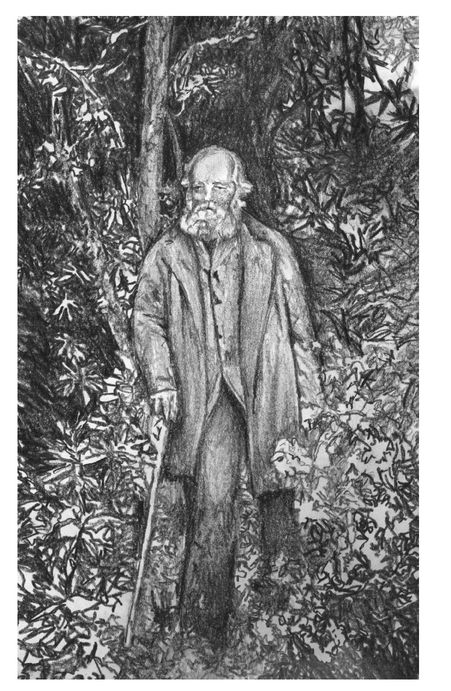The Rags of Time (29 page)
Authors: Maureen Howard


He sends for his family. They make the best of Mariposa, live comfortably over the Company Store, camp out, take pleasure in the rugged territory of this West, its timeless lakes and extravagant mountains far from their natural habitat, the water effects and mild hillocks of the Park across Eighth Avenue.
The mines are mined out. Chinese are put to panning in streams of the Merced River for the least glitter. There’s mention of an oil well, but primitive equipment can’t drill to depth, no yield, though there will be in the spoilage plotted if—this year, next year, 2008—the protection of Yosemite is violated.
We ride every day to the top of the mountain, where Mrs. O and I are doing some child’s play gardening work, and where we make tea—in sight of the Yo Semite & 5000 feet high—the change of air from the valley being delicious.
—Letter to Calvert Vaux, June 8, 1865
By this time his salary—reason he took the job—is no longer paid by the fraudulent board of the Mariposa Mining Corporation.
“Think of it? I think it is but a lot of granite rubbish and nasty glittering mica that isn’t worth ten cents an acre!”
So vanished my dream. So melted my wealth away. So toppled my airy castle to earth and left me stricken and forlorn.
—Roughing It,
but Mark Twain wrote of silver, not gold
but Mark Twain wrote of silver, not gold
Had Frederick Law Olmsted been hired to give stature to a bankrupt claim? Hard to make the best of that. Meanwhile, Fred improves the rowdy frontier within his reach. Discovering the culture of the Golden West impoverished, he establishes a lending library; writes a proposal to preserve Yosemite and Big Tree Grove as a wilderness park, first of its kind in our country. Out of a job, he thinks to stay on in California. To Vaux:
I can safely calculate on getting three times as large an interest on my accumulated capital, as I could in the East.
Capitalists here generally regard it—the Santa Barbara & other New York Cal Petroleum companies—as stupendous swindles, ala Mariposa. I think they are not swindles but they are gambles.
Meanwhile, Mary Olmsted plans a camping trip that will take her to fourteen hundred feet. Pert and smart, solo adventures suited Mary who did what she pleased. He invested in a vineyard, growing grapes in the sunshine, a good gamble. Why did he come back to New York, to his work in the Park? It’s never explained in his letters. A speculator, not a biographer, I’m curious, the detective’s daughter. In my hometown of Bridgeport, the Park City, we have two parks, Seaside and Beardsley, both by the Olmsted firm. When he was young, my grandfather broke rocks for the seawall down at Seaside. I rode my bike to Beardsley in the North End, fed my lunch to the caged deer, never knew the park maker’s name. Olmsted’s improvement of our city was all that we had by way of recreation: a dig in the sand with a view of Long Island Sound; a miniature zoo with monkeys, chatty parrots, a few peacocks fanning their tails. Meanwhile, Singer Sewing and GE chugged in slow motion during the Depression. By the time I was twelve and rode my bike to one park or the other, the factories had geared up for the war, that war. It would be a while before I knew that our country, coast to coast, is blessed with extensive Olmstediana, before I took an interest in Paradise Pond on my college grounds and those of Berkeley and Amherst, Prospect Park, and looked into the City Beautiful Movement with its many consoling cemeteries.
There is something unsettling about Olmsted’s swift recovery from his misfortune so far from his upright Yankee world. I believe—biographers allowed?—that letters from his partner, Calvert Vaux, the more experienced landscape artist, goaded him to invest once again in his profession. Vaux was the little guy, a transplant from England, trailing the great man, working with earnest devotion at his job in the Park. His talent was immense. I forgive his overinvestment, his devotion to storybook nature and the picturesque, and his corny rustic benches and arbors. He designed the most elegant ironworks of the era. Machine-tempered, his bridges adorn the garden across the street. Fred’s swagger cast his partner in a supporting role. Vaux cared about that injury. They had it out in long letters during the Mariposa years, heated exchanges raking over the past, settling into a quibble about titles awarded to Fred:
Superintendent, Architect in Chief
. Yet they were bound to each other. Vaux’s letters to Olmsted woke me from the archival swamp sucking the adjunct biographer under. As though hovering above the rectangular dream of the Greensward, Vaux viewed from on high all that the city and its people must yearn for—Ramble, Meer, Cascade, Parade Grounds of his democratic vista. He is faithful, passionate, true to his dream. For a while I believed I’d fallen in love with the wrong man. Vaux staked his impossible claims for art—a heartbreaking proposition, don’t I know. To Olmsted, 1863:
Superintendent, Architect in Chief
. Yet they were bound to each other. Vaux’s letters to Olmsted woke me from the archival swamp sucking the adjunct biographer under. As though hovering above the rectangular dream of the Greensward, Vaux viewed from on high all that the city and its people must yearn for—Ramble, Meer, Cascade, Parade Grounds of his democratic vista. He is faithful, passionate, true to his dream. For a while I believed I’d fallen in love with the wrong man. Vaux staked his impossible claims for art—a heartbreaking proposition, don’t I know. To Olmsted, 1863:
I am mixed up in these affairs and am proceeding in a very half and half sort of way for alone I am a very incomplete Landscape Architect and you are off at the other end of the world, depriving the public of your proper services as I argue. My position is that the art element ought to have been the controlling element. . . .
In all this I may be mistaken. You may be no artist. You may be Nap III in disguise. You may be a selfish fellow, who would like to get power & reputation on other men’s brains. You may be a money grubber. You may have no patience &c &c, but it is to be presumed by my acting as I do that I think differently and that I am under the impression that the humble modest artist spirit is within you. If so, and if you can, taking art in its widest sense, devote yourself to it, your chance was never better than it is today.
I believe the Park to be the big art work of the Republic. I have always felt it would be mean on the part of its makers to let the success be an administration success—it would seem as if they were ashamed of their work.

Olmsted would not take on the mantle of artist, not when he returned to resume his work on the Park, not when he was pleased with the Brooklyn Park built in continuing partnership with Vaux. Just a land scaper, difficult to place him in
Lives of the Artists,
or
Saints,
or demote Fred to almanac entry, a touch of the recoverable past, with my grandfather heaving slate stone to his design, nothing to gain as in working the pathos of Columbus begging for royal privileges, or the mythmaking of Raleigh’s El Dorado preserved in our haute bourgeois lobby.
Lives of the Artists,
or
Saints,
or demote Fred to almanac entry, a touch of the recoverable past, with my grandfather heaving slate stone to his design, nothing to gain as in working the pathos of Columbus begging for royal privileges, or the mythmaking of Raleigh’s El Dorado preserved in our haute bourgeois lobby.
Old and exhausted by his trade, Olmsted is persuaded to sign on as Landscape Architect of the World’s Columbian Exposition. He is seventy years old, could not resist the offer, was brought on board for his fame, I suppose. Built of insubstantial stuff, the exposition’s White City is faux classical: imperial boulevards, Greek pillars, and many Italian-ate domes draw more than the calculated millions to the four hundred years of progress and entertainments on the Midway Plaisance. Olmsted attempts to soften the architectural grandeur with greenery, then retreats offshore to create his Wooded Island and Lagoon with a Japanese temple. The man-made Lake had worked in Central Park. Why not make Lake Michigan perform? His refuge from the White City’s vulgarity is planted with tropical flora he admired in Panama and Acapulco. The imports wilt in the heat of the Chicago summer. By that time he had moved household and business to Brookline, Massachusetts, where his sons prosper in the family trade. I have trouble forgiving him. We both found our way to New York from Connecticut’s manufacturing cities. Olmsted had a good run, Park rupture and all. Now the Boston Brahmins sought him out for their Arboretum. It was time to think of industrial growth disfiguring the city. He designs small arboreal jewels to ring round Boston, the Emerald Necklace, and enjoys the refinement up there, I suppose.
For seven years, a long decline, he lives with Mary in the McLean Asylum, taking what pleasure he can in its conservatory gardens. Does he know he designed them? They are maintained in their glory. Dr. Bhuvaneswar, once my student, walked her troubled patients on the healing woodland paths during her residency in psychiatry. I find the famous landscape gardener online: the portrait by John Singer Sargent, weight on the good leg; weak eyes dreamy, turned inward. Fred’s posted between rhododendrons—buds swollen, flowering kalmia and the last blooms of shad, the native dogwood that flares white among the pines in our scant acre in Monterey. He’s on the grounds of the Biltmore, the Vanderbilt estate in North Carolina, his last commission. Olmsted was for an Arboretum, not the simulacra of an English village to be set within the grounds. He disliked the clearing, mourned the loss of trees here and across America, joined in the first efforts of reforestation. Still sharp, Fred had saved the sequoia forest back in Mariposa days, yet he now detected his mental dislocation. Sargent’s portrait—moving, though I prefer a photo of the old couple picnicking at the asylum: He’s propped by a tree, straw hat shadowing his vision, lost to this world. Mary’s abandoned herself to a patch of bare ground, frizz of white hair in disarray.

Olmsted is not at once informed of his partner’s death—a suicide, some biographers claim; that dramatic note in keeping with Vaux’s passion. Arguments with the Parks Commission again: He designed, then demanded that the drive for traffic to be built along the Hudson River must have a scenic walkway. One hundred years later, the promenade is near completion. It ends at 125th Street, at a wharf with sturdy benches, frail saplings, a stunning view of the Palisades.
Olmsted’s writing is the best history of him: in his papers, I find notes toward an essay never finished:
The Pioneer Condition and the Drift of Civilization.
Not surprising that he returned to his literary calling to speak of the wilderness as rough and uncivil. The Chinese serving the miners were miserably treated; so were the Indians. Olmsted’s lending library was a gentleman’s gesture in the surround of guns and whiskey, barroom brawls. Desperados! Ever the reformer, he aimed to take our beloved Westerns out of the West, but that show already had its run. Buffalo Bill Cody was quick on the draw at the White City. For twenty years Indians had staged war dances at Barnum’s American Museum on Broadway. All he wanted, for Christ’s sake—
Mimi, your language—
was a civil society. At Mariposa he had sketched out proposals for a school, perhaps a dry-goods emporium like his father’s in Hartford. He suggested that a journal, the
Nation,
be founded, and served for a while as an editor. I do not imagine he expected that its liberal views would be widely distributed among the semiliterate staging their barroom scenes. For
The Pioneer Condition,
he read up as his mind clouded, all sorts of enlightening books: Goethe, Thackeray, Washington Irving. The fragments of that essay read as notes for a sermon he could no longer deliver; yet he’s fine in his overreaching to
make common cause with all who are inconsiderably abused.
Still dusting off the phrase “Literary Republic”? He surely read Mark Twain, who wrote the frontier story strong and true in
Roughing It,
1872. Absorbed on his return from Mariposa to the unfinished business of Central Park, gentrifying the Wild West was not as pressing as slavery when he traveled the seaboard states. Like Huck, Fred lit out for the Territory but turned back to the
sivilized
city.
The Pioneer Condition and the Drift of Civilization.
Not surprising that he returned to his literary calling to speak of the wilderness as rough and uncivil. The Chinese serving the miners were miserably treated; so were the Indians. Olmsted’s lending library was a gentleman’s gesture in the surround of guns and whiskey, barroom brawls. Desperados! Ever the reformer, he aimed to take our beloved Westerns out of the West, but that show already had its run. Buffalo Bill Cody was quick on the draw at the White City. For twenty years Indians had staged war dances at Barnum’s American Museum on Broadway. All he wanted, for Christ’s sake—
Mimi, your language—
was a civil society. At Mariposa he had sketched out proposals for a school, perhaps a dry-goods emporium like his father’s in Hartford. He suggested that a journal, the
Nation,
be founded, and served for a while as an editor. I do not imagine he expected that its liberal views would be widely distributed among the semiliterate staging their barroom scenes. For
The Pioneer Condition,
he read up as his mind clouded, all sorts of enlightening books: Goethe, Thackeray, Washington Irving. The fragments of that essay read as notes for a sermon he could no longer deliver; yet he’s fine in his overreaching to
make common cause with all who are inconsiderably abused.
Still dusting off the phrase “Literary Republic”? He surely read Mark Twain, who wrote the frontier story strong and true in
Roughing It,
1872. Absorbed on his return from Mariposa to the unfinished business of Central Park, gentrifying the Wild West was not as pressing as slavery when he traveled the seaboard states. Like Huck, Fred lit out for the Territory but turned back to the
sivilized
city.
Other books
Expensive People by Joyce Carol Oates
Nine Lives: A Lily Dale Mystery by Wendy Corsi Staub
Photo Finish by Kris Norris
Something Right Behind Her by Claire Hollander
It's Not About You by Olivia Reid
Ghosts of Karnak by George Mann
The Panther and The Pearl by Doreen Owens Malek
Her Bear To Keep (Second Chance Shifters 5) by Meredith Clarke
Lurulu by Jack Vance
If This Is Paradise, I Want My Money Back by Claudia Carroll
